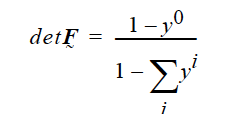Stress Free Solvent Vol Frac#
Stress Free Solvent Vol Frac = CONSTANT <float> []
Description / Usage#
This required card is used to specify the model for the stress-free solvent volume fraction, which is the volume fraction of solvents in the solid material in its stress-free state. This card is used exclusively in materials of LAGRANGIAN or TOTAL_ALE Mesh Motion types (see Mesh Motion card) which are being modeled as gelled solids laden with solvent. At the gel-point, the solid is considered to be stress free, after which a reduction of solvent leads to volume shrinkage and hence a rising stress state. Definitions of the input parameters are as follows:
CONSTANT |
Name of the model for the stress-free solvent volume fraction. |
<float> |
The value of the stress-free solvent volume fraction; this value is unitless. |
Examples#
The following is a sample card:
Stress Free Solvent Vol Frac = CONSTANT 0.5
This specification sets the volume fraction of solvent in the material to 50 per cent. That volume fraction is tantamount to the gel point of the material.
Technical Discussion#
The stress free state volume fraction of solvent is basically the solvent fraction at which a material gels, viz., the state at which the material solidifies from a liquid state. This quantity is used in the continuity equation for incompressible solid materials, through which is transported by a variety of diffusion models (see Diffusivity card). The continuity equation, viz., EQ = continuity, is applied as follows:

where the dependent variable is the solid phase pressure (see Solid Constitutive Equation card). Here det F is the determinant of the deformation gradient tensor, yi is the volume fraction of component i (specified by the EQ = species_bulk card), and y0 is the volume fraction of total solvents at the stress free state. Clearly, as the solvent concentration decreases the local volume of solid decreases, creating a rising stress.
References#
GT-001.4: GOMA and SEAMS tutorial for new users, February 18, 2002, P. R. Schunk and D. A. Labreche
GT-019.1: Elastoviscoplastic (EVP) Constitutive Model in GOMA: Theory, Testing, and Tutorial, P. R. Schunk, A. Sun, S. Y. Tam (Imation Corp.) and K. S. Chen, January 11, 2001
SAND96-2149: Drying in Deformable Partially-Saturated Porous Media: Sol-Gel Coatings, Cairncross, R. A., P. R. Schunk, K. S. Chen, S. S. Prakash, J. Samuel, A. J. Hurd and C. Brinker (September 1996)
